Steelhead Fishing NY: Guide Tips To Catch More Steelhead
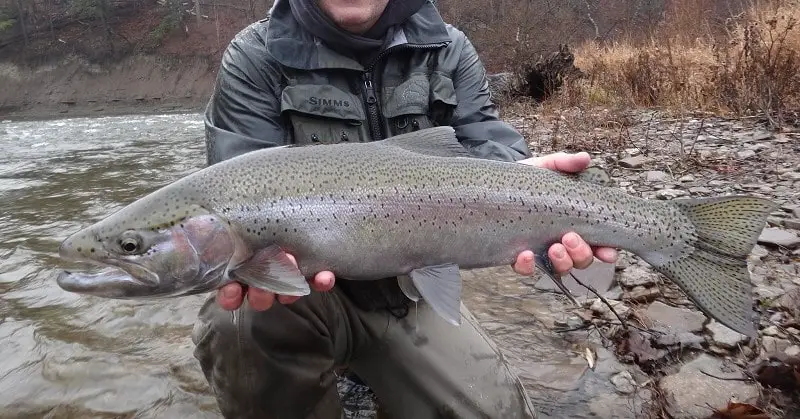
New York has big steelhead runs, and thousands of anglers flock to the state’s tributaries every year to hook these monster-sized trout. Steelhead fishing in NY requires anglers to adapt to changing water patterns, temperatures, and seasons.
I have been fishing steelhead in NY rivers for almost 20 years, and these are the tips and tactics that I use when guiding for steelhead to catch a lot of steelhead.
New York Steelhead Rivers
The New York steelhead is stocked by the millions into the rivers flowing into Lake Ontario and Lake Erie, which helps create this fantastic fishery.
Some steelhead can also reproduce naturally and are born wild in the rivers. The baby Steelhead instinctually migrate through these tributaries to the Great Lakes, where they will feed and grow big for one to three years before heading back to the tributaries to spawn as large adults.
This migration of adult steelhead up the rivers is when thousands of anglers visit these tributaries to fish.
Upstate New York steelhead fishing is split into two regions. Region One is the shoreline of Lake Ontario, and Region Two is the shoreline of Lake Erie south of the city of Buffalo. Both regions have great steelhead rivers that rival some of the famous West Coast steelhead rivers.
The Lake Ontario side of upstate New York has many great rivers, including some that might be the best steelhead rivers in the Great Lakes region or even in the world.
The Lake Erie side of New York also has many great steelhead rivers and is part of what is called Steelhead Alley. Steelhead Alley is an area with numerous tributaries from Buffalo to Ohio. See Steelhead Alley Fishing: Tactics And Tips From Guides.
Every year, the rivers in Steelhead Alley are stocked with over 500,000 steelheads averaging about eight inches long, making for some fantastic steelhead fishing.
Best Time Fish For Steelhead In NY
The NY steelhead fishing season runs from early fall to late spring. The steelhead season typically starts around late September with cooler nights or cold rains and runs through early May, which is when most steelhead are finished spawning and have headed back to the lake to recover.
Spring Steelhead Fishing In NY
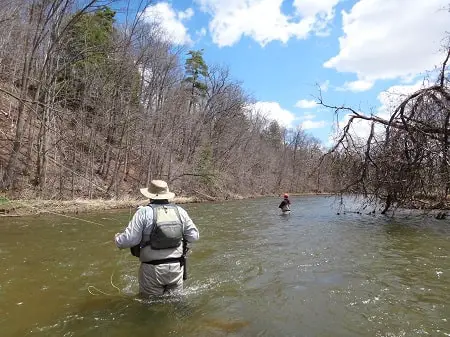
Many people consider spring one of the best times to fish for Steelhead in NY.
This is because the water temperatures are gradually getting warmer which triggers the spring runs.
I split the spring steelhead into 3 groups to help my clients understand the steelhead better which helps them catch more fish.
Group one steelhead are fresh steelhead just came into the river the lake and they are silver, aggressive, and full of energy. These fish start their runs with the snow melts and when the deep freeze of winter is finally over, which is usually around early March.
Group two are the steelhead that are up on the spawning beds spawning. These steelhead should be left alone to spawn and make more steelhead for future runs.
Group 3 are steelhead that have already spawned and are heading back to the lake. Some anglers call these steelhead “dropbacks” or “dropdown steelhead”.
These drop-back steelhead are always hungry, are often very aggressive, and they fight much better than steelhead on the spawning beds do. These fish are often found later in the spring and can offer excellent angling.
For more information, best baits, best methods, and tips, check out my page Spring Steelhead Fishing
Fall Steelhead Fishing In New York
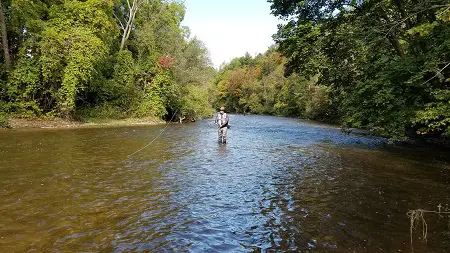
As the nights become colder and the water temperatures cool down in late September, through October, and November, more Steelhead start entering the rivers in larger numbers.
The cold nights and the cold rains of October will trigger the bigger runs.
These fall steelheads are big, strong, and healthy from feeding all summer in the lake, they are aggressive and they are often the hardest fishing steelhead of the year.
Late October into early November is an ideal time for fall steelhead fishing because the water is cold enough to motivate the steelhead to run but still warm enough that the fish are moving and are very active and willing to eat.
I change tactics in the fall as the water gets colder and so should you.
Where the steelhead hold in the river in early October, and when they are most active or when they eat, and which methods that work best then, are often different than they are in late November or in December.
Not knowing how to adapt as the water gets colder is why many anglers really struggle to catch steelhead as the water gets colder.
For more information, guide tips, and tactics to stay on the steelhead at all times during the late fall steelhead run, check out my page Fall Fishing For Steelhead.
Winter Steelhead Fishing
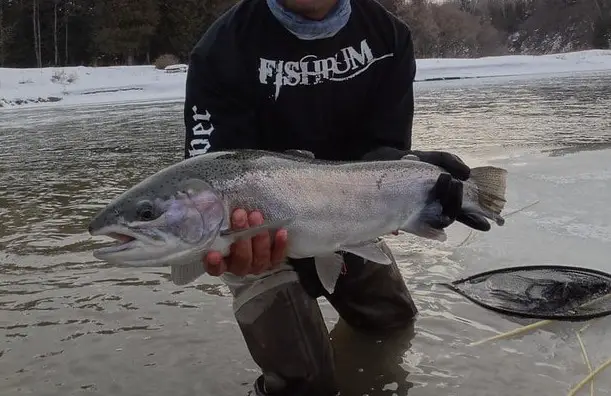
The migratory winter run strain of steelhead consists of what some call the Washington Steelhead strain.
You will still see a lot of Steelhead in the river during the winter months, but you will also notice that they are not as active and are less likely to feed.
Knowing when and where to fish for winter steelhead can really improve your success.
You may also have trouble fishing some of the more shallow creeks and streams in New York since these smaller creeks may freeze over first in the winter. There are some New York rivers that practically stay ice-free all winter.
The good news is that the steelhead at this time will have a harder time finding natural food during the winter, so if you can get them interested and moving, they will be hungry and should be willing to bite your bait.
My article Winter Steelhead Fishing explains how to consistently catch steelhead even in the coldest water. Knowing my tips and tricks that I use to keep my clients catching lots of steelhead is included on that page as well as my tips to stay warmer and safe.
Steelhead Fishing Regulations
New York does have regulations or fishing rules that apply to Steelhead fishing.
These regulations include information about fishing hours, season dates, tackle restrictions, fishing licenses, and fishing locations you can or cannot fish at different times.
You can find an extensive list of regulations on the New York Department Of Environmental Conservation website.
The Best Methods For Catching Steelhead In NY
Some fishing methods for steelhead work better than others when it comes to fishing New York rivers and streams.
Here are some methods to try if you want to be successful when fishing for.
Fly Fishing
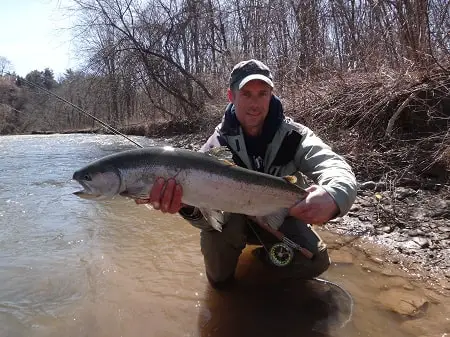
Many fishermen prefer fly fishing for Steelhead in New York, and this is a method that works well in all seasons and on most rivers.
The catch is that you need to know how to do it well.
If you are not catching steelhead when fly fishing, I highly recommend you check out my article Fly Fishing For Steelhead: Great Lakes Style. The methods, flies, tips, and tricks that I share have been proven to work exceptionally well on New York Rivers.
I recommend sticking to rivers that average 3 to 8 feet deep, which is almost all of the New York steelhead rivers.
Steelhead should be eager to hit on flies anytime and on all NY steelhead rivers. You just need to be sure that you are using the right flies and that you present them properly.
When fly fishing, it’s a good idea to bring various types of flies with you so you can adapt to different water conditions or feeding patterns. A fly that worked yesterday in slightly dirty water might not work in clearer water.
You should also use different fly techniques. Spey fishing is a popular fly fishing technique that works well when fishing for Steelheads in New York’s bigger tributaries. Rivers like the Salmon River, Oswego, and 18-mile creeks can be fished with Spey rods.
Nymph Fishing for steelhead is usually the most effective way to catch steelhead with a fly rod. In shallow water or when fishing pocket water, I prefer a little-known nymphing method known as Euro Nymphing.
If done right and if used in the right type of water, Euro Nymphing can be the most effective way to catch lots of steelhead.
I have adapted the Euro nymphing methods used by the pros to catch Great Lakes steelhead consistently. Check out my page on Euro Nymphing For Steelhead.
The most common way to nymph for steelhead is known as indicator fishing. Done right, this can be the most effective method of fishing steelhead in bigger, deeper pools and runs. For more information, check out my page Nymphing For Great Lakes Steelhead.
Best Flies For NY Steelhead Fishing
There are some flies that work better than others when fishing for Steelhead in New York and these are some popular ones to try.
- Nuke Egg Fly #10 in colors: cheese yellow, pink, peach, orange, and chartreuse for dirty water.
- Copper John nymph size 8 to 10
- Egg Sucking Leech in size 6 to 8: same colors as the Nuke Egg fly usually with a black or olive body.
- Woolly bugger in sizes 8 to 10 in colors white, black, olive, and purple.
- Grapefruit Head Leech ( for swinging or stripping in)
- White Beadhead Crystal Bugger – # 10 in colors white, black, olive, and purple.
- Senyo’s Shaggy Minnow (For swinging or stripping)
- Crystal Egg Fly in size 8 to 10 – Same colors as the Nuke Egg Fly
- Blood Dot Egg Fly in size 8 to 10 – same colors as the Nuke Egg fly usually with a black or olive
- Psycho Prince size 8 – 12
For more top flies check out my page 19 Most Effective Steelhead Flies and my page Winter Steelhead Flies: 11 Must Have Guide Flies
Float Fishing
Float fishing might be your best option in almost all NY rivers simply because it effectively presents baits like minnows, salmon eggs, worms, and beads.
The float keeps your bait suspended off the bottom and since the steelhead are almost always on the bottom you can keep your bait suspended in their strike zone for a long time.
This is also a good method if you are fishing in the late fall and winter when the waters are cold and a slower presentation is required.
Float fishing can be done with spinning reels, and baitcasting reels, but nothing beats float fishing with Centerpin reels.
If Centerpin fishing is something you are interested in, check out Centerpin Fishing For Beginners: 20 Steps From A Top Guide.
For detailed info on how to float fish and the methods and gear that the expert guides use, check out my page on Float Fishing: Tips From A Pro River Guide For More Trout.
Bottom Bouncing
Bottom bouncing allows you to get your bait to the bottom of the river or stream without a float. Some anglers know this as drift fishing.
This method is the best when fishing pocket water, and in shallower runs and pools.
I discuss both traditional style bottom bouncing methods that are used in shallow and deep water, and the advanced bottom bouncing methods that I use when I am guiding on my page Bottom Bouncing – 5 Proven Guide Tips For More Fish
Drift Fishing
If you are fishing with light tackle and longer rods, drift fishing can be effective. This method is when you cast your bait out into the current with some weight on your line, no float, and let it drift along with the current. You maintain a semi-tight line to help detect strikes as the bait bumps and bounces along the bottom.
Finding the right speed is the most important factor.
This method shines when fishing water over ten feet deep where it’s difficult to use a float.
For more info on this method check out my page Drift Fishing For Steelhead.
Best Baits And Lures For Steelhead Fishing
When Steelhead fishing NY, it’s a good idea to have plenty of different baits available so you can interchange them as needed to adapt to water conditions or the fish’s preference. Make sure you have some of these in your tackle box.
Live Bait
- Eggs Sacs
- Worms
- Beads
- Flies
- Minnows
- Grubs
If you want to know my favorite steelhead baits, how to make these baits more effective, and how I figure out which baits are best, check out my very popular page Best Baits For Steelhead.
Lure Fishing For Steelhead In New York
Lure fishing for Steelhead in New York can be a lot of fun and is often very effective. There are a lot of great steelhead rivers in New York that are suitable for casting lures.
Knowing which lures to use, when to use them, and how to fish them will greatly increase the amount of steelhead that you catch.
For starters, anglers should have these lures when fishing steelhead in New York.
Lures
- Spoons 2 to 4 inches
- Crankbait lures 3 to 5 inches
- Spinners
- Jigs
- Plugs
For more information on lure fishing, which sizes and colors are best, and my secret lure that most anglers forget about, check out my page 4 Best Lures For Steelhead – A Pro Guides Recommendations.
Best Steelhead Rivers In NY
Here are some of the best rivers in New York for Steelhead fishing. Maps of these rivers can be found here.
- Cattaraugus Creek
- Oswego River
- Salmon River
- Niagara River
- Genesee River
- Eighteen Mile Creek
There are over 50 more rivers and streams in New York where anglers can fish for steelhead and I discuss them in more detail on my page Best Steelhead Rivers Of New York.
Water Levels On NY Tributaries
Before you head out for some New York Steelhead fishing, it’s a good idea to check out the water levels of the New York rivers that you are planning to fish.
Rivers that are too low might be void of any steelhead, and rivers that are too high might be muddy, dangerous, or just impossible to fish.
Knowing when the rivers come up and how fast they drop back to fishable levels can help you predict the steelhead runs.
All the guides and top anglers use the Water levels charts and so should you. You can find current river conditions for stream flows on the USGS National Water Information website.
Tight Lines,
Graham

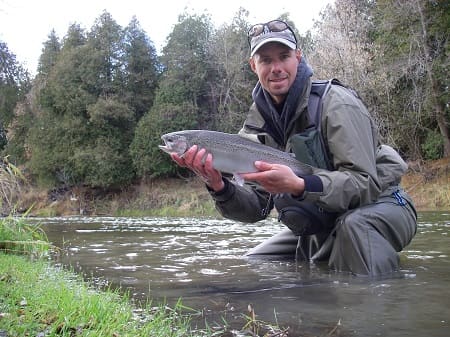
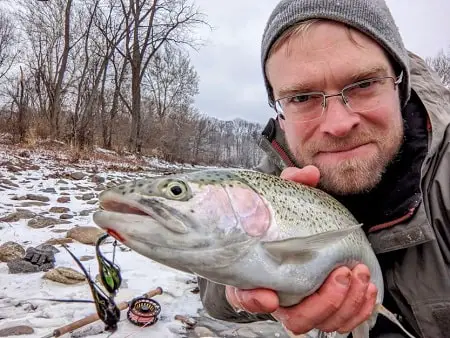
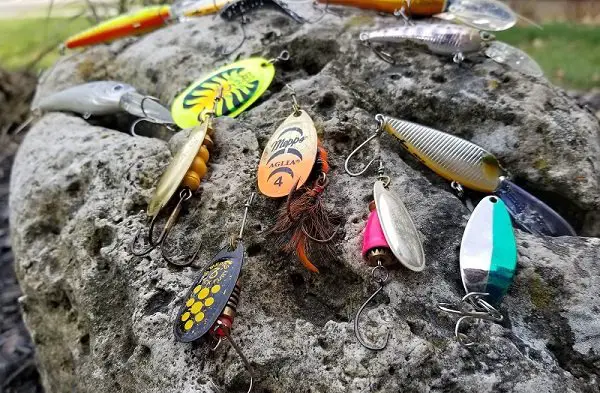
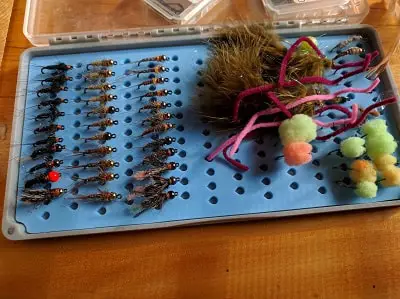
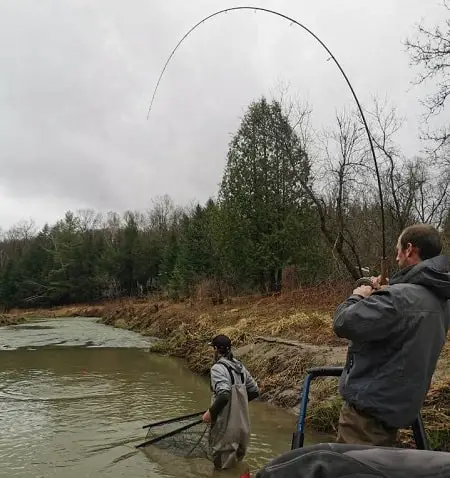
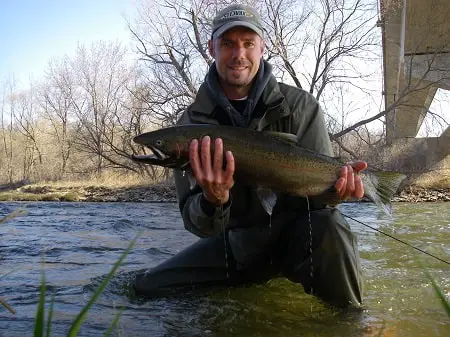
Hi Graham,
Are you guiding for steelhead in the Lake Erie Lake Ontario watersheds?
Sincerely,
Rodney
Hey Rodney,
I’ve put most of my guiding on hold for this year to work on the website and a new YouTube Channel, Therefore, I won’t be guiding those rivers, but I will be fishing them 🙂
I’m sure there are some good guides in those areas.
Best of luck,
Graham